Project Management Report: Wroxham Case Study and Project Analysis
VerifiedAdded on 2020/11/23
|14
|3845
|302
Report
AI Summary
This report provides a comprehensive overview of project management principles and practices. It begins with an introduction to project characteristics, including core principles and their importance, followed by a discussion on defining project scope, Gantt charts, critical paths, and developing project budgets. The report then explores risk strategy development and quality methods. The second part of the report presents a case study on Wroxham boat builders, focusing on the skills and competencies required for a project manager implementing an ERP system, as well as the project life cycle phases. The report covers essential aspects such as execution, decision-making, communication, and technical competence, providing a well-rounded understanding of project management in both theoretical and practical contexts.
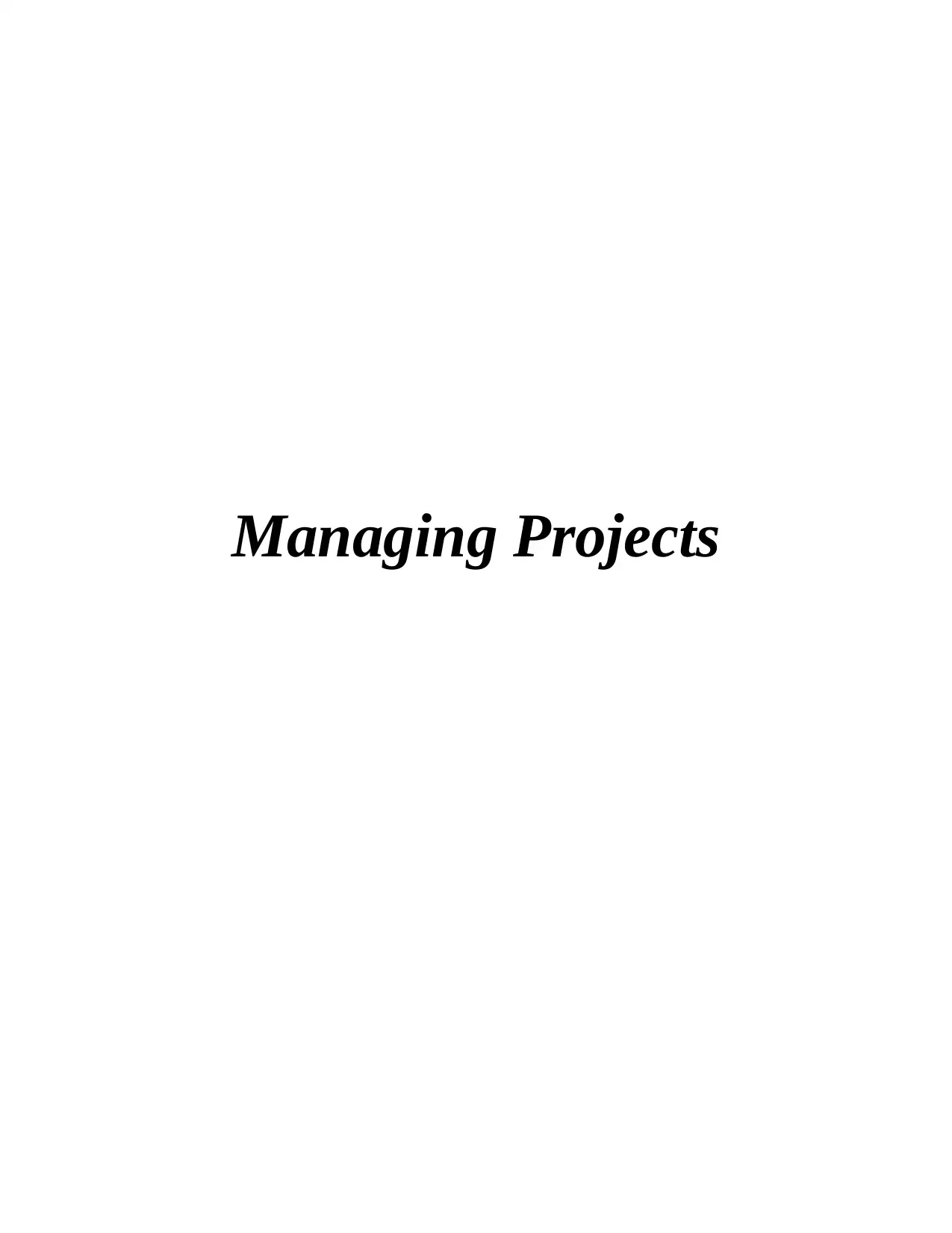
Managing Projects
Paraphrase This Document
Need a fresh take? Get an instant paraphrase of this document with our AI Paraphraser
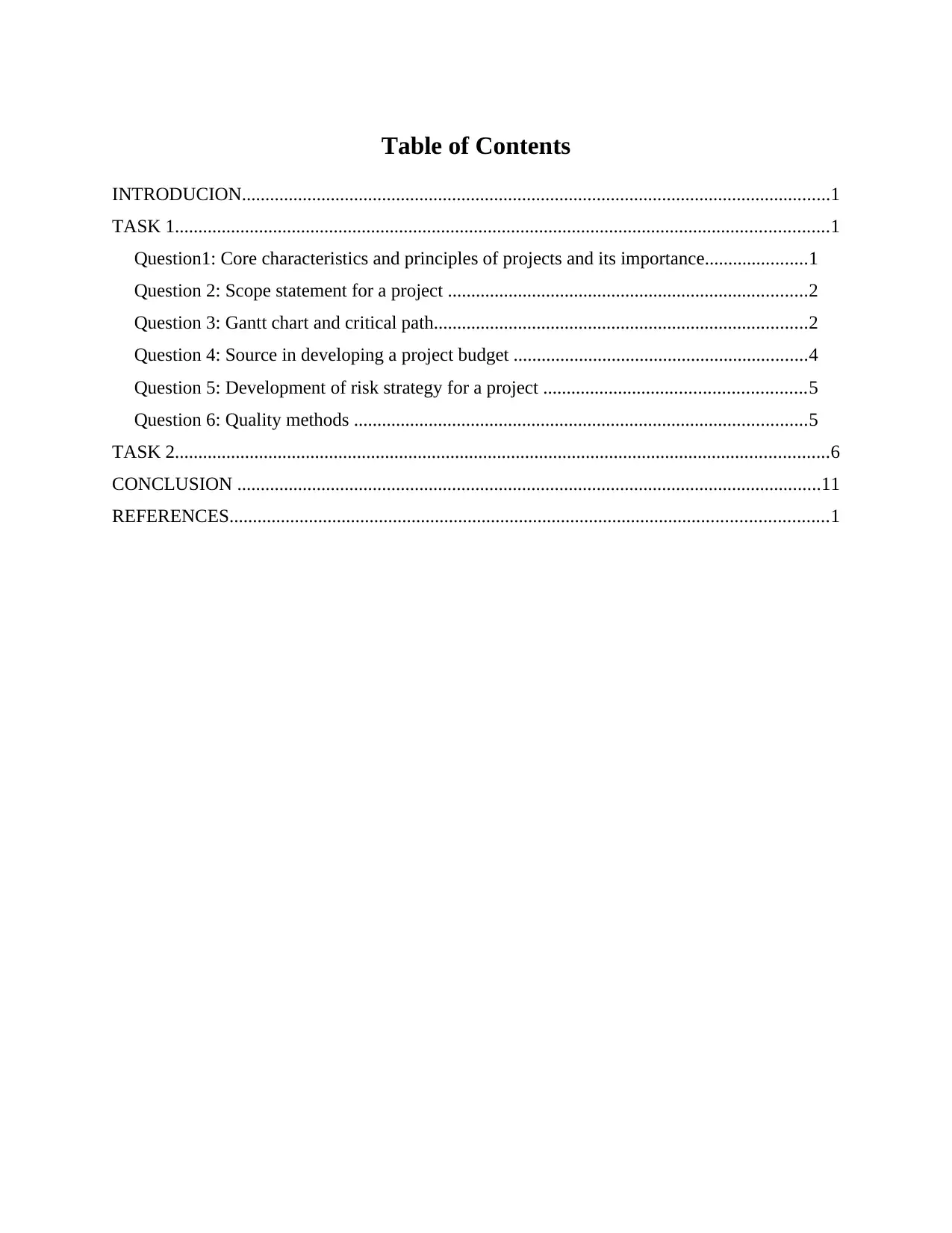
Table of Contents
INTRODUCION..............................................................................................................................1
TASK 1............................................................................................................................................1
Question1: Core characteristics and principles of projects and its importance......................1
Question 2: Scope statement for a project .............................................................................2
Question 3: Gantt chart and critical path................................................................................2
Question 4: Source in developing a project budget ...............................................................4
Question 5: Development of risk strategy for a project ........................................................5
Question 6: Quality methods .................................................................................................5
TASK 2............................................................................................................................................6
CONCLUSION .............................................................................................................................11
REFERENCES................................................................................................................................1
INTRODUCION..............................................................................................................................1
TASK 1............................................................................................................................................1
Question1: Core characteristics and principles of projects and its importance......................1
Question 2: Scope statement for a project .............................................................................2
Question 3: Gantt chart and critical path................................................................................2
Question 4: Source in developing a project budget ...............................................................4
Question 5: Development of risk strategy for a project ........................................................5
Question 6: Quality methods .................................................................................................5
TASK 2............................................................................................................................................6
CONCLUSION .............................................................................................................................11
REFERENCES................................................................................................................................1
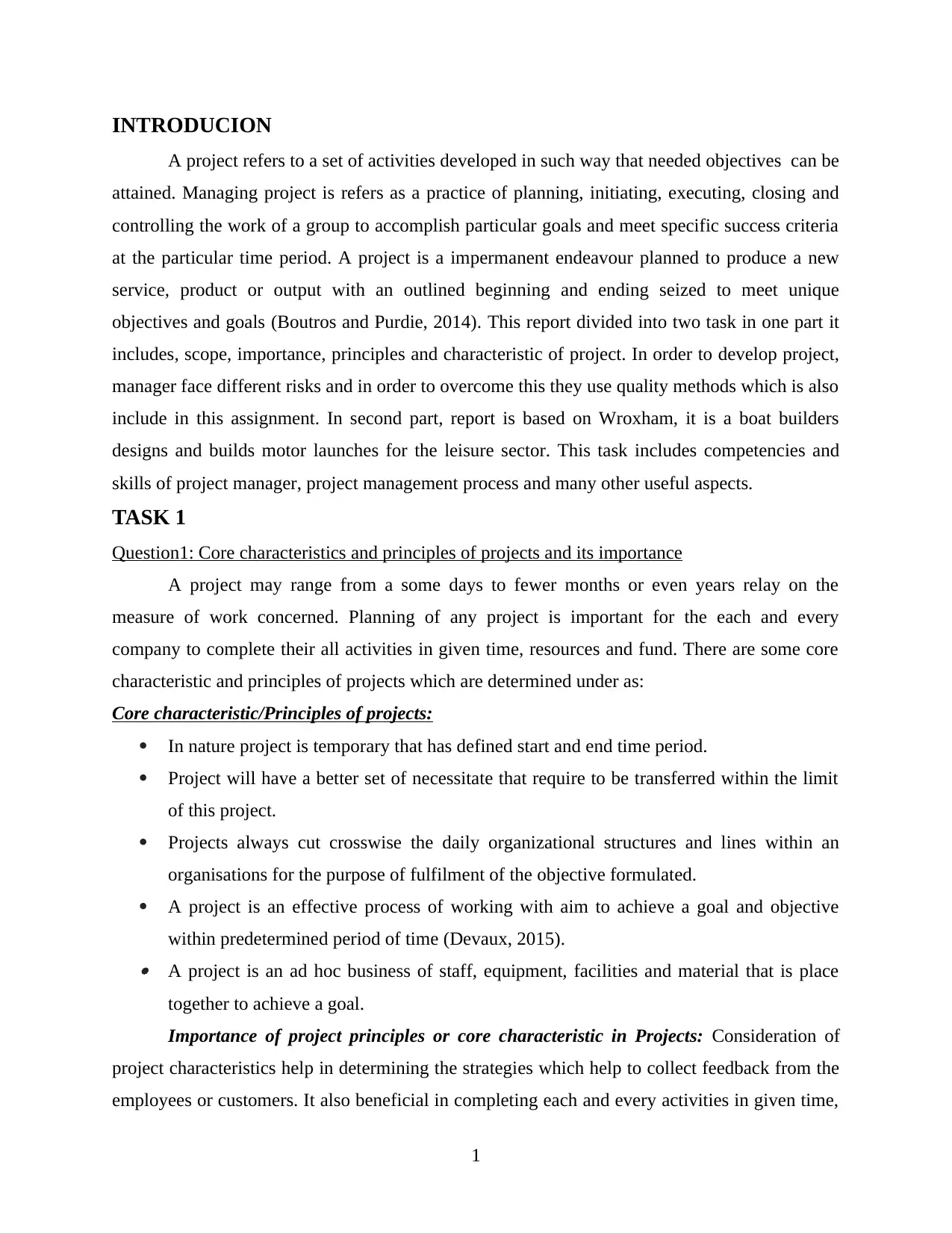
INTRODUCION
A project refers to a set of activities developed in such way that needed objectives can be
attained. Managing project is refers as a practice of planning, initiating, executing, closing and
controlling the work of a group to accomplish particular goals and meet specific success criteria
at the particular time period. A project is a impermanent endeavour planned to produce a new
service, product or output with an outlined beginning and ending seized to meet unique
objectives and goals (Boutros and Purdie, 2014). This report divided into two task in one part it
includes, scope, importance, principles and characteristic of project. In order to develop project,
manager face different risks and in order to overcome this they use quality methods which is also
include in this assignment. In second part, report is based on Wroxham, it is a boat builders
designs and builds motor launches for the leisure sector. This task includes competencies and
skills of project manager, project management process and many other useful aspects.
TASK 1
Question1: Core characteristics and principles of projects and its importance
A project may range from a some days to fewer months or even years relay on the
measure of work concerned. Planning of any project is important for the each and every
company to complete their all activities in given time, resources and fund. There are some core
characteristic and principles of projects which are determined under as:
Core characteristic/Principles of projects:
In nature project is temporary that has defined start and end time period.
Project will have a better set of necessitate that require to be transferred within the limit
of this project.
Projects always cut crosswise the daily organizational structures and lines within an
organisations for the purpose of fulfilment of the objective formulated.
A project is an effective process of working with aim to achieve a goal and objective
within predetermined period of time (Devaux, 2015). A project is an ad hoc business of staff, equipment, facilities and material that is place
together to achieve a goal.
Importance of project principles or core characteristic in Projects: Consideration of
project characteristics help in determining the strategies which help to collect feedback from the
employees or customers. It also beneficial in completing each and every activities in given time,
1
A project refers to a set of activities developed in such way that needed objectives can be
attained. Managing project is refers as a practice of planning, initiating, executing, closing and
controlling the work of a group to accomplish particular goals and meet specific success criteria
at the particular time period. A project is a impermanent endeavour planned to produce a new
service, product or output with an outlined beginning and ending seized to meet unique
objectives and goals (Boutros and Purdie, 2014). This report divided into two task in one part it
includes, scope, importance, principles and characteristic of project. In order to develop project,
manager face different risks and in order to overcome this they use quality methods which is also
include in this assignment. In second part, report is based on Wroxham, it is a boat builders
designs and builds motor launches for the leisure sector. This task includes competencies and
skills of project manager, project management process and many other useful aspects.
TASK 1
Question1: Core characteristics and principles of projects and its importance
A project may range from a some days to fewer months or even years relay on the
measure of work concerned. Planning of any project is important for the each and every
company to complete their all activities in given time, resources and fund. There are some core
characteristic and principles of projects which are determined under as:
Core characteristic/Principles of projects:
In nature project is temporary that has defined start and end time period.
Project will have a better set of necessitate that require to be transferred within the limit
of this project.
Projects always cut crosswise the daily organizational structures and lines within an
organisations for the purpose of fulfilment of the objective formulated.
A project is an effective process of working with aim to achieve a goal and objective
within predetermined period of time (Devaux, 2015). A project is an ad hoc business of staff, equipment, facilities and material that is place
together to achieve a goal.
Importance of project principles or core characteristic in Projects: Consideration of
project characteristics help in determining the strategies which help to collect feedback from the
employees or customers. It also beneficial in completing each and every activities in given time,
1
⊘ This is a preview!⊘
Do you want full access?
Subscribe today to unlock all pages.

Trusted by 1+ million students worldwide
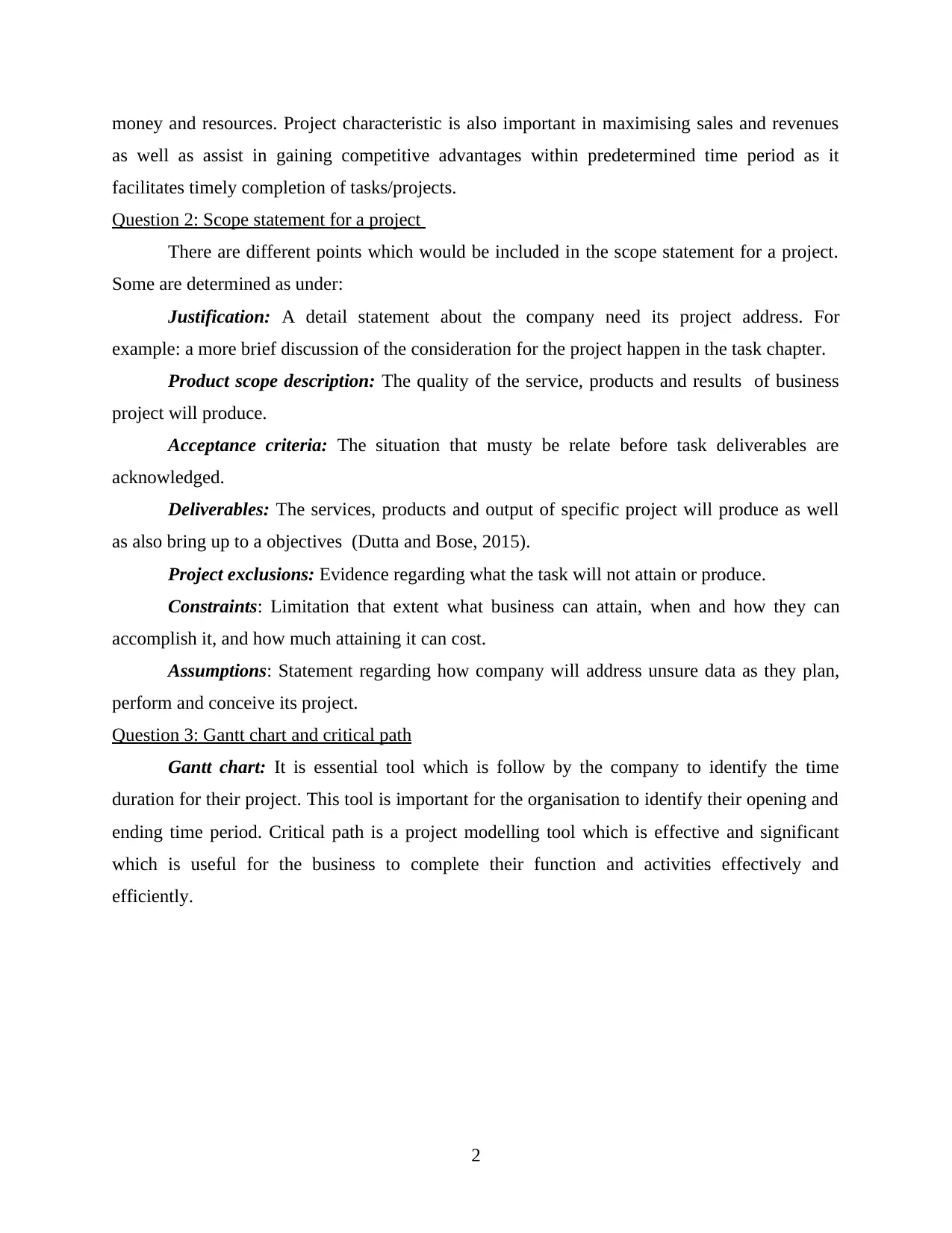
money and resources. Project characteristic is also important in maximising sales and revenues
as well as assist in gaining competitive advantages within predetermined time period as it
facilitates timely completion of tasks/projects.
Question 2: Scope statement for a project
There are different points which would be included in the scope statement for a project.
Some are determined as under:
Justification: A detail statement about the company need its project address. For
example: a more brief discussion of the consideration for the project happen in the task chapter.
Product scope description: The quality of the service, products and results of business
project will produce.
Acceptance criteria: The situation that musty be relate before task deliverables are
acknowledged.
Deliverables: The services, products and output of specific project will produce as well
as also bring up to a objectives (Dutta and Bose, 2015).
Project exclusions: Evidence regarding what the task will not attain or produce.
Constraints: Limitation that extent what business can attain, when and how they can
accomplish it, and how much attaining it can cost.
Assumptions: Statement regarding how company will address unsure data as they plan,
perform and conceive its project.
Question 3: Gantt chart and critical path
Gantt chart: It is essential tool which is follow by the company to identify the time
duration for their project. This tool is important for the organisation to identify their opening and
ending time period. Critical path is a project modelling tool which is effective and significant
which is useful for the business to complete their function and activities effectively and
efficiently.
2
as well as assist in gaining competitive advantages within predetermined time period as it
facilitates timely completion of tasks/projects.
Question 2: Scope statement for a project
There are different points which would be included in the scope statement for a project.
Some are determined as under:
Justification: A detail statement about the company need its project address. For
example: a more brief discussion of the consideration for the project happen in the task chapter.
Product scope description: The quality of the service, products and results of business
project will produce.
Acceptance criteria: The situation that musty be relate before task deliverables are
acknowledged.
Deliverables: The services, products and output of specific project will produce as well
as also bring up to a objectives (Dutta and Bose, 2015).
Project exclusions: Evidence regarding what the task will not attain or produce.
Constraints: Limitation that extent what business can attain, when and how they can
accomplish it, and how much attaining it can cost.
Assumptions: Statement regarding how company will address unsure data as they plan,
perform and conceive its project.
Question 3: Gantt chart and critical path
Gantt chart: It is essential tool which is follow by the company to identify the time
duration for their project. This tool is important for the organisation to identify their opening and
ending time period. Critical path is a project modelling tool which is effective and significant
which is useful for the business to complete their function and activities effectively and
efficiently.
2
Paraphrase This Document
Need a fresh take? Get an instant paraphrase of this document with our AI Paraphraser
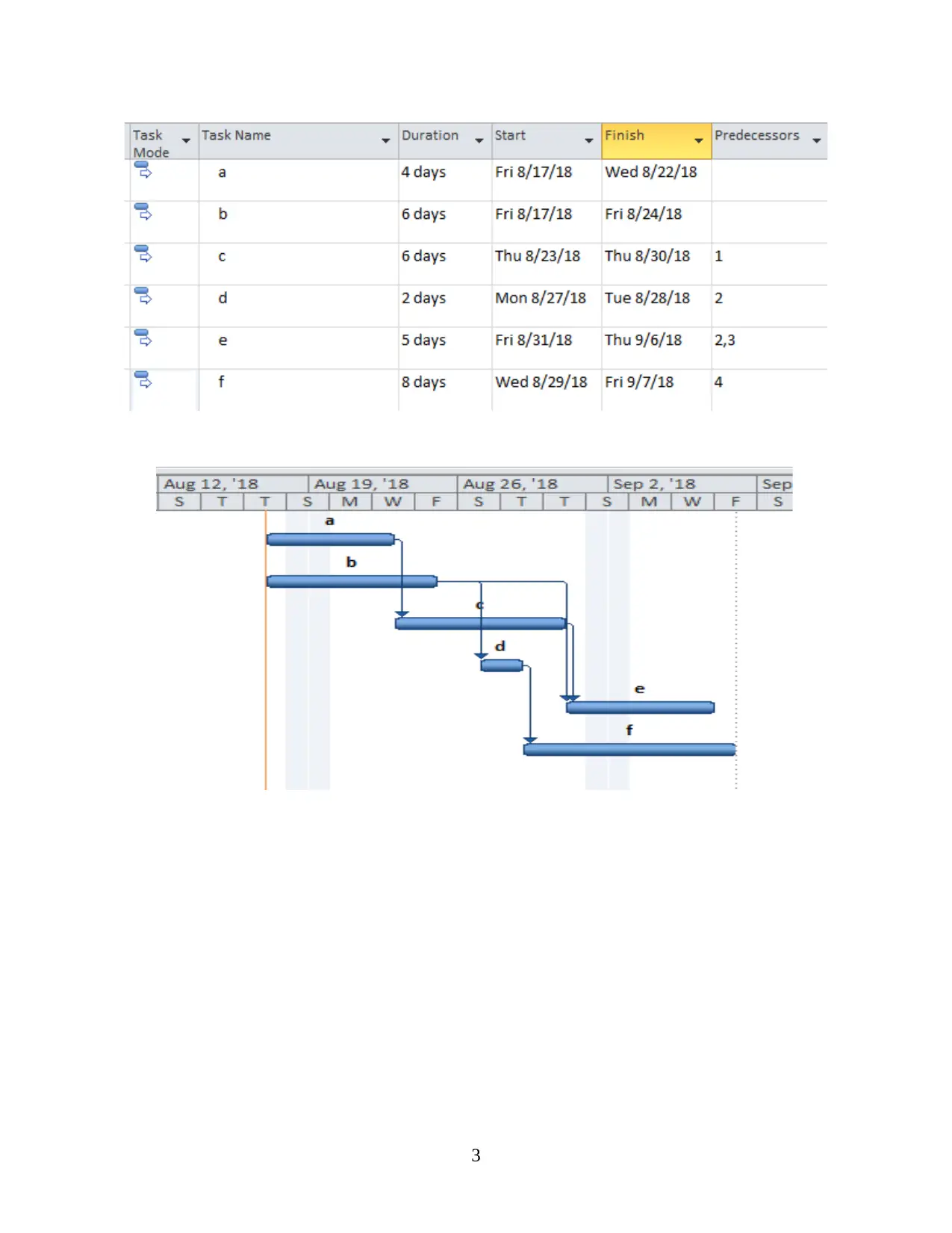
3
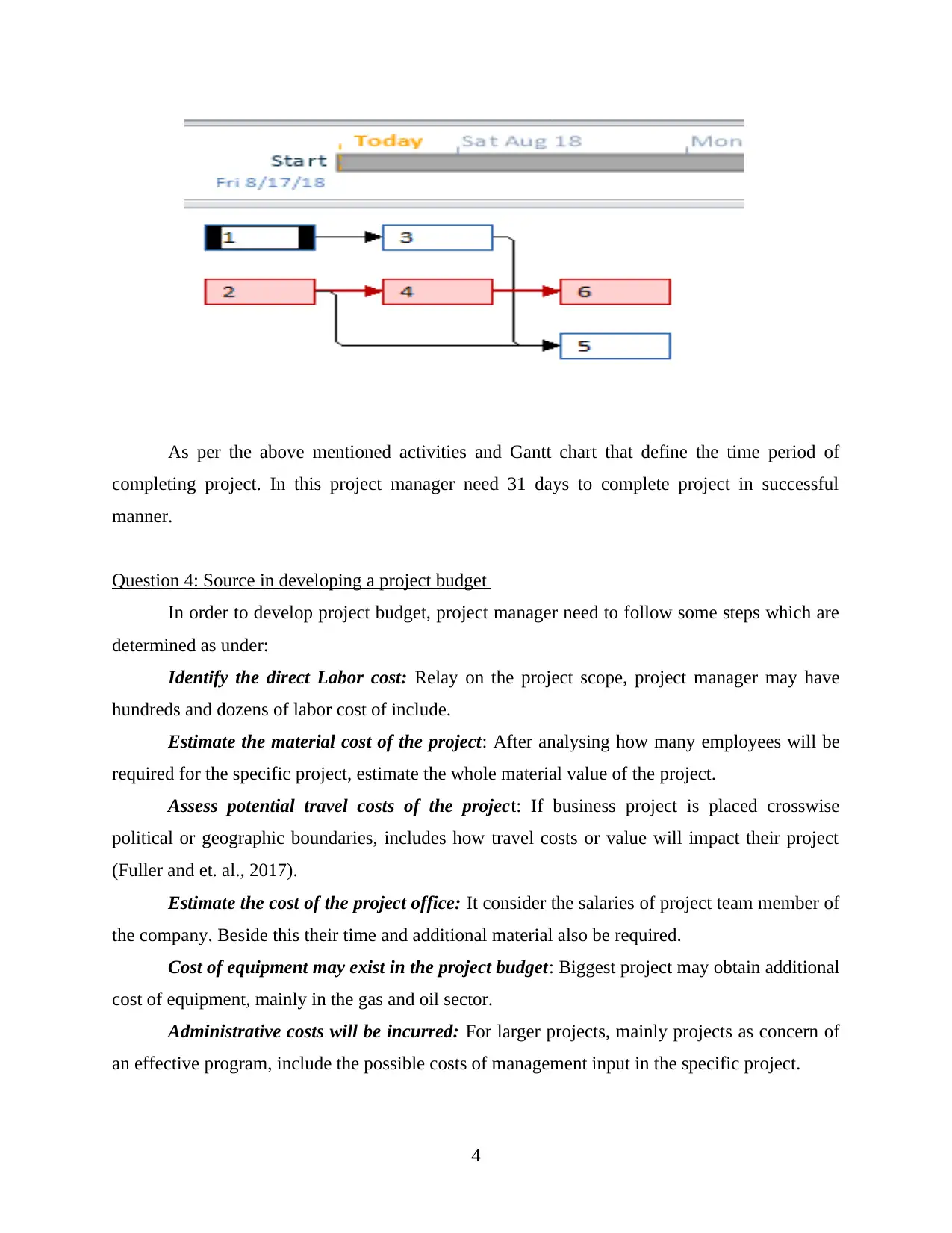
As per the above mentioned activities and Gantt chart that define the time period of
completing project. In this project manager need 31 days to complete project in successful
manner.
Question 4: Source in developing a project budget
In order to develop project budget, project manager need to follow some steps which are
determined as under:
Identify the direct Labor cost: Relay on the project scope, project manager may have
hundreds and dozens of labor cost of include.
Estimate the material cost of the project: After analysing how many employees will be
required for the specific project, estimate the whole material value of the project.
Assess potential travel costs of the project: If business project is placed crosswise
political or geographic boundaries, includes how travel costs or value will impact their project
(Fuller and et. al., 2017).
Estimate the cost of the project office: It consider the salaries of project team member of
the company. Beside this their time and additional material also be required.
Cost of equipment may exist in the project budget: Biggest project may obtain additional
cost of equipment, mainly in the gas and oil sector.
Administrative costs will be incurred: For larger projects, mainly projects as concern of
an effective program, include the possible costs of management input in the specific project.
4
completing project. In this project manager need 31 days to complete project in successful
manner.
Question 4: Source in developing a project budget
In order to develop project budget, project manager need to follow some steps which are
determined as under:
Identify the direct Labor cost: Relay on the project scope, project manager may have
hundreds and dozens of labor cost of include.
Estimate the material cost of the project: After analysing how many employees will be
required for the specific project, estimate the whole material value of the project.
Assess potential travel costs of the project: If business project is placed crosswise
political or geographic boundaries, includes how travel costs or value will impact their project
(Fuller and et. al., 2017).
Estimate the cost of the project office: It consider the salaries of project team member of
the company. Beside this their time and additional material also be required.
Cost of equipment may exist in the project budget: Biggest project may obtain additional
cost of equipment, mainly in the gas and oil sector.
Administrative costs will be incurred: For larger projects, mainly projects as concern of
an effective program, include the possible costs of management input in the specific project.
4
⊘ This is a preview!⊘
Do you want full access?
Subscribe today to unlock all pages.

Trusted by 1+ million students worldwide
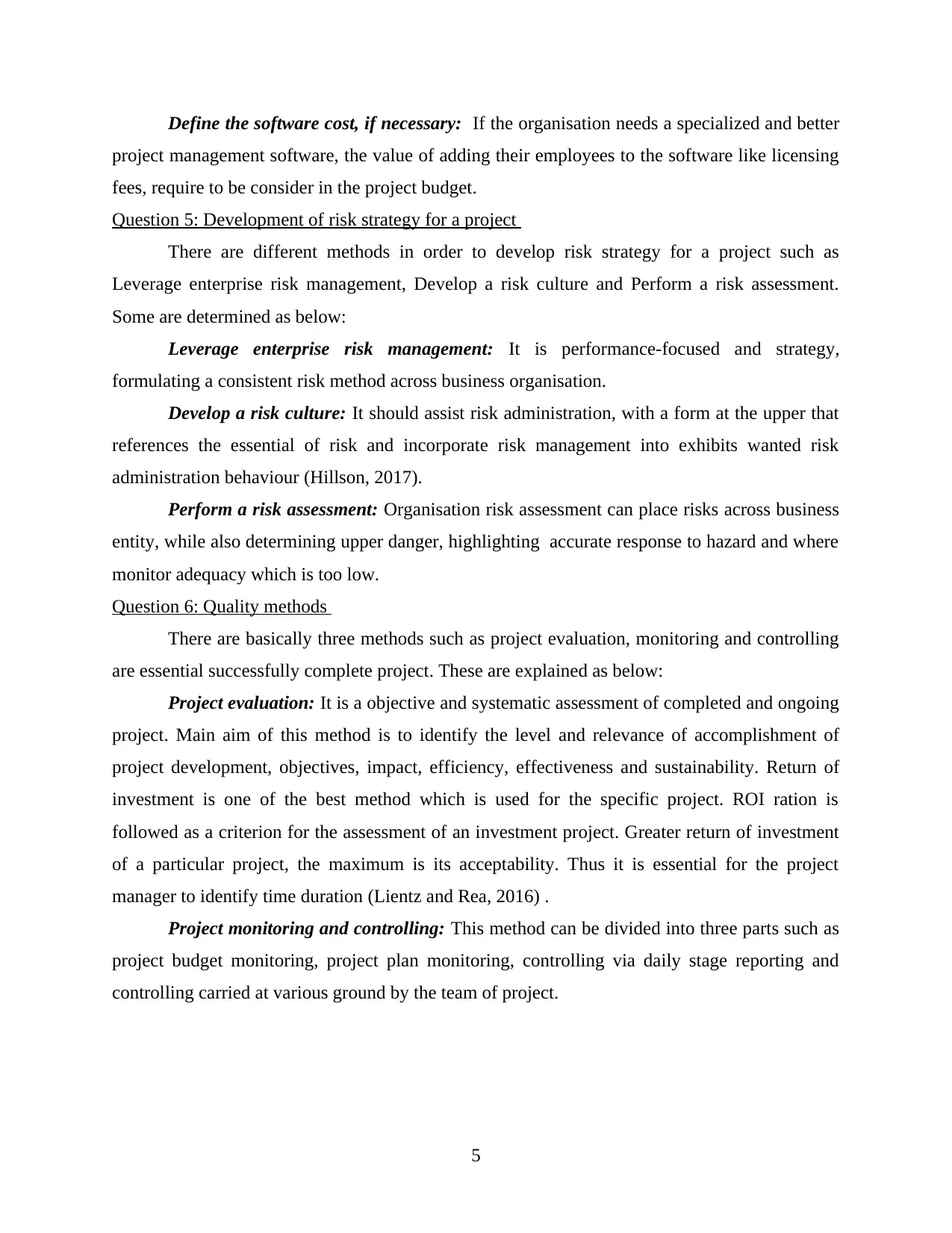
Define the software cost, if necessary: If the organisation needs a specialized and better
project management software, the value of adding their employees to the software like licensing
fees, require to be consider in the project budget.
Question 5: Development of risk strategy for a project
There are different methods in order to develop risk strategy for a project such as
Leverage enterprise risk management, Develop a risk culture and Perform a risk assessment.
Some are determined as below:
Leverage enterprise risk management: It is performance-focused and strategy,
formulating a consistent risk method across business organisation.
Develop a risk culture: It should assist risk administration, with a form at the upper that
references the essential of risk and incorporate risk management into exhibits wanted risk
administration behaviour (Hillson, 2017).
Perform a risk assessment: Organisation risk assessment can place risks across business
entity, while also determining upper danger, highlighting accurate response to hazard and where
monitor adequacy which is too low.
Question 6: Quality methods
There are basically three methods such as project evaluation, monitoring and controlling
are essential successfully complete project. These are explained as below:
Project evaluation: It is a objective and systematic assessment of completed and ongoing
project. Main aim of this method is to identify the level and relevance of accomplishment of
project development, objectives, impact, efficiency, effectiveness and sustainability. Return of
investment is one of the best method which is used for the specific project. ROI ration is
followed as a criterion for the assessment of an investment project. Greater return of investment
of a particular project, the maximum is its acceptability. Thus it is essential for the project
manager to identify time duration (Lientz and Rea, 2016) .
Project monitoring and controlling: This method can be divided into three parts such as
project budget monitoring, project plan monitoring, controlling via daily stage reporting and
controlling carried at various ground by the team of project.
5
project management software, the value of adding their employees to the software like licensing
fees, require to be consider in the project budget.
Question 5: Development of risk strategy for a project
There are different methods in order to develop risk strategy for a project such as
Leverage enterprise risk management, Develop a risk culture and Perform a risk assessment.
Some are determined as below:
Leverage enterprise risk management: It is performance-focused and strategy,
formulating a consistent risk method across business organisation.
Develop a risk culture: It should assist risk administration, with a form at the upper that
references the essential of risk and incorporate risk management into exhibits wanted risk
administration behaviour (Hillson, 2017).
Perform a risk assessment: Organisation risk assessment can place risks across business
entity, while also determining upper danger, highlighting accurate response to hazard and where
monitor adequacy which is too low.
Question 6: Quality methods
There are basically three methods such as project evaluation, monitoring and controlling
are essential successfully complete project. These are explained as below:
Project evaluation: It is a objective and systematic assessment of completed and ongoing
project. Main aim of this method is to identify the level and relevance of accomplishment of
project development, objectives, impact, efficiency, effectiveness and sustainability. Return of
investment is one of the best method which is used for the specific project. ROI ration is
followed as a criterion for the assessment of an investment project. Greater return of investment
of a particular project, the maximum is its acceptability. Thus it is essential for the project
manager to identify time duration (Lientz and Rea, 2016) .
Project monitoring and controlling: This method can be divided into three parts such as
project budget monitoring, project plan monitoring, controlling via daily stage reporting and
controlling carried at various ground by the team of project.
5
Paraphrase This Document
Need a fresh take? Get an instant paraphrase of this document with our AI Paraphraser
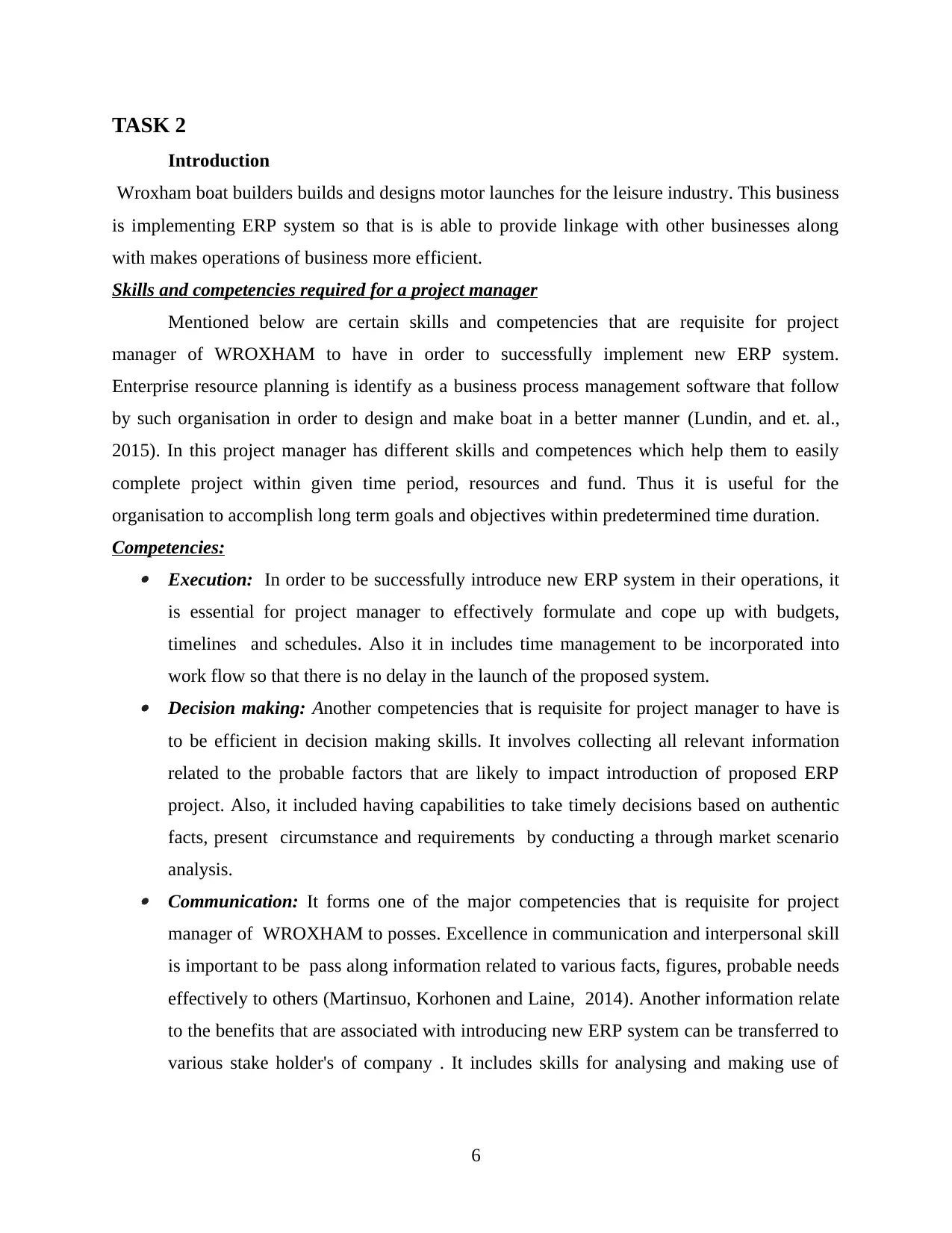
TASK 2
Introduction
Wroxham boat builders builds and designs motor launches for the leisure industry. This business
is implementing ERP system so that is is able to provide linkage with other businesses along
with makes operations of business more efficient.
Skills and competencies required for a project manager
Mentioned below are certain skills and competencies that are requisite for project
manager of WROXHAM to have in order to successfully implement new ERP system.
Enterprise resource planning is identify as a business process management software that follow
by such organisation in order to design and make boat in a better manner (Lundin, and et. al.,
2015). In this project manager has different skills and competences which help them to easily
complete project within given time period, resources and fund. Thus it is useful for the
organisation to accomplish long term goals and objectives within predetermined time duration.
Competencies: Execution: In order to be successfully introduce new ERP system in their operations, it
is essential for project manager to effectively formulate and cope up with budgets,
timelines and schedules. Also it in includes time management to be incorporated into
work flow so that there is no delay in the launch of the proposed system. Decision making: Another competencies that is requisite for project manager to have is
to be efficient in decision making skills. It involves collecting all relevant information
related to the probable factors that are likely to impact introduction of proposed ERP
project. Also, it included having capabilities to take timely decisions based on authentic
facts, present circumstance and requirements by conducting a through market scenario
analysis. Communication: It forms one of the major competencies that is requisite for project
manager of WROXHAM to posses. Excellence in communication and interpersonal skill
is important to be pass along information related to various facts, figures, probable needs
effectively to others (Martinsuo, Korhonen and Laine, 2014). Another information relate
to the benefits that are associated with introducing new ERP system can be transferred to
various stake holder's of company . It includes skills for analysing and making use of
6
Introduction
Wroxham boat builders builds and designs motor launches for the leisure industry. This business
is implementing ERP system so that is is able to provide linkage with other businesses along
with makes operations of business more efficient.
Skills and competencies required for a project manager
Mentioned below are certain skills and competencies that are requisite for project
manager of WROXHAM to have in order to successfully implement new ERP system.
Enterprise resource planning is identify as a business process management software that follow
by such organisation in order to design and make boat in a better manner (Lundin, and et. al.,
2015). In this project manager has different skills and competences which help them to easily
complete project within given time period, resources and fund. Thus it is useful for the
organisation to accomplish long term goals and objectives within predetermined time duration.
Competencies: Execution: In order to be successfully introduce new ERP system in their operations, it
is essential for project manager to effectively formulate and cope up with budgets,
timelines and schedules. Also it in includes time management to be incorporated into
work flow so that there is no delay in the launch of the proposed system. Decision making: Another competencies that is requisite for project manager to have is
to be efficient in decision making skills. It involves collecting all relevant information
related to the probable factors that are likely to impact introduction of proposed ERP
project. Also, it included having capabilities to take timely decisions based on authentic
facts, present circumstance and requirements by conducting a through market scenario
analysis. Communication: It forms one of the major competencies that is requisite for project
manager of WROXHAM to posses. Excellence in communication and interpersonal skill
is important to be pass along information related to various facts, figures, probable needs
effectively to others (Martinsuo, Korhonen and Laine, 2014). Another information relate
to the benefits that are associated with introducing new ERP system can be transferred to
various stake holder's of company . It includes skills for analysing and making use of
6
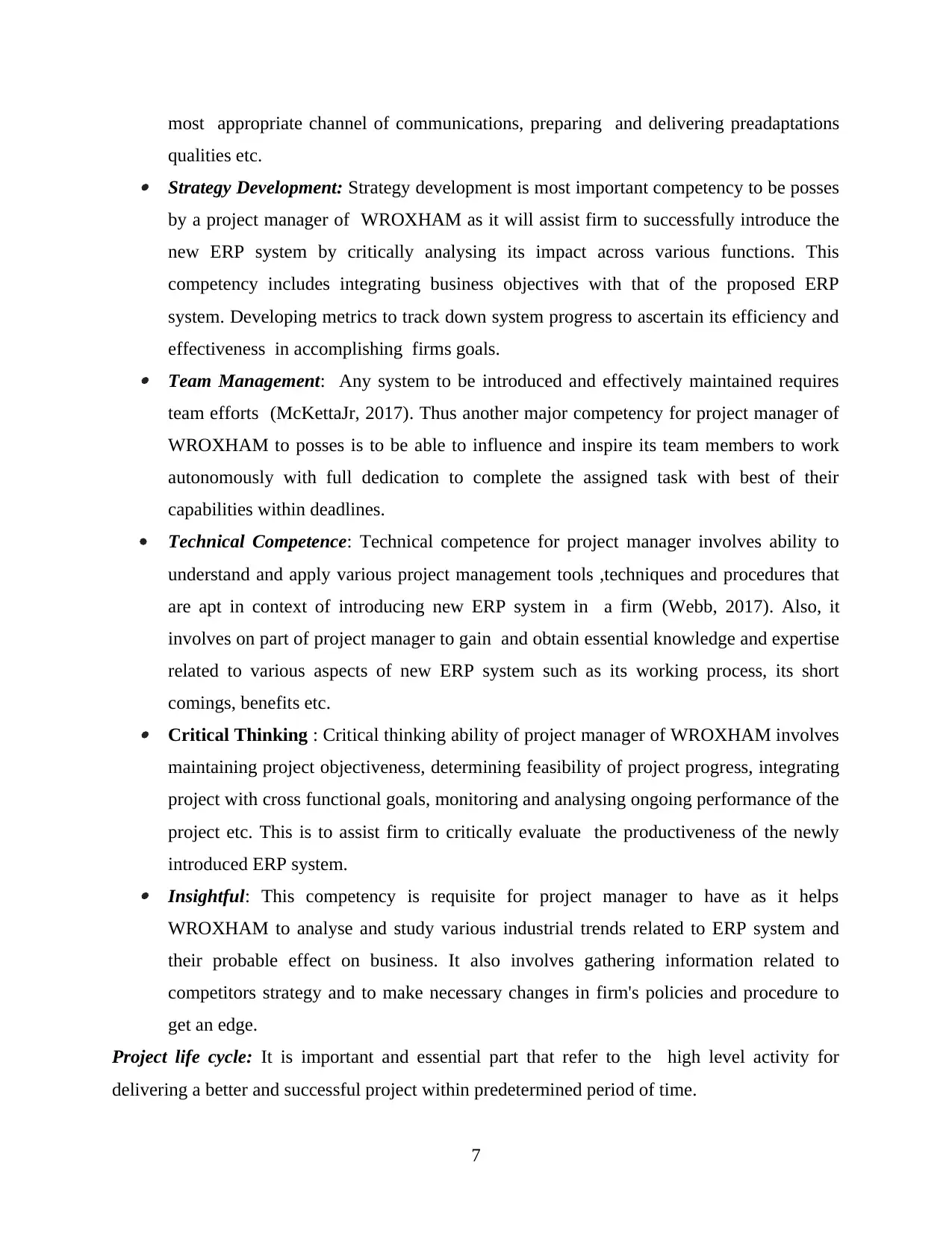
most appropriate channel of communications, preparing and delivering preadaptations
qualities etc. Strategy Development: Strategy development is most important competency to be posses
by a project manager of WROXHAM as it will assist firm to successfully introduce the
new ERP system by critically analysing its impact across various functions. This
competency includes integrating business objectives with that of the proposed ERP
system. Developing metrics to track down system progress to ascertain its efficiency and
effectiveness in accomplishing firms goals. Team Management: Any system to be introduced and effectively maintained requires
team efforts (McKettaJr, 2017). Thus another major competency for project manager of
WROXHAM to posses is to be able to influence and inspire its team members to work
autonomously with full dedication to complete the assigned task with best of their
capabilities within deadlines.
Technical Competence: Technical competence for project manager involves ability to
understand and apply various project management tools ,techniques and procedures that
are apt in context of introducing new ERP system in a firm (Webb, 2017). Also, it
involves on part of project manager to gain and obtain essential knowledge and expertise
related to various aspects of new ERP system such as its working process, its short
comings, benefits etc. Critical Thinking : Critical thinking ability of project manager of WROXHAM involves
maintaining project objectiveness, determining feasibility of project progress, integrating
project with cross functional goals, monitoring and analysing ongoing performance of the
project etc. This is to assist firm to critically evaluate the productiveness of the newly
introduced ERP system. Insightful: This competency is requisite for project manager to have as it helps
WROXHAM to analyse and study various industrial trends related to ERP system and
their probable effect on business. It also involves gathering information related to
competitors strategy and to make necessary changes in firm's policies and procedure to
get an edge.
Project life cycle: It is important and essential part that refer to the high level activity for
delivering a better and successful project within predetermined period of time.
7
qualities etc. Strategy Development: Strategy development is most important competency to be posses
by a project manager of WROXHAM as it will assist firm to successfully introduce the
new ERP system by critically analysing its impact across various functions. This
competency includes integrating business objectives with that of the proposed ERP
system. Developing metrics to track down system progress to ascertain its efficiency and
effectiveness in accomplishing firms goals. Team Management: Any system to be introduced and effectively maintained requires
team efforts (McKettaJr, 2017). Thus another major competency for project manager of
WROXHAM to posses is to be able to influence and inspire its team members to work
autonomously with full dedication to complete the assigned task with best of their
capabilities within deadlines.
Technical Competence: Technical competence for project manager involves ability to
understand and apply various project management tools ,techniques and procedures that
are apt in context of introducing new ERP system in a firm (Webb, 2017). Also, it
involves on part of project manager to gain and obtain essential knowledge and expertise
related to various aspects of new ERP system such as its working process, its short
comings, benefits etc. Critical Thinking : Critical thinking ability of project manager of WROXHAM involves
maintaining project objectiveness, determining feasibility of project progress, integrating
project with cross functional goals, monitoring and analysing ongoing performance of the
project etc. This is to assist firm to critically evaluate the productiveness of the newly
introduced ERP system. Insightful: This competency is requisite for project manager to have as it helps
WROXHAM to analyse and study various industrial trends related to ERP system and
their probable effect on business. It also involves gathering information related to
competitors strategy and to make necessary changes in firm's policies and procedure to
get an edge.
Project life cycle: It is important and essential part that refer to the high level activity for
delivering a better and successful project within predetermined period of time.
7
⊘ This is a preview!⊘
Do you want full access?
Subscribe today to unlock all pages.

Trusted by 1+ million students worldwide
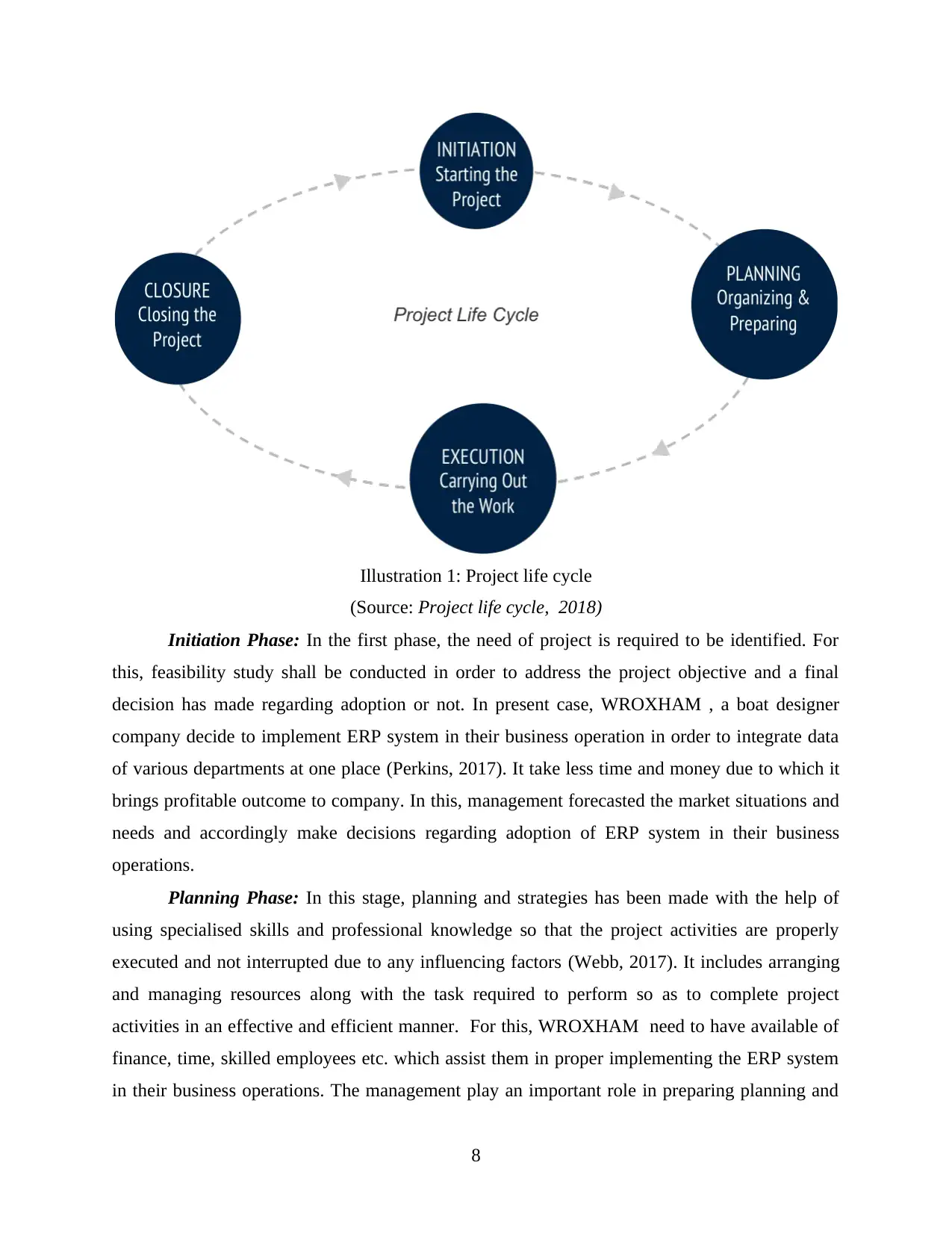
(Source: Project life cycle, 2018)
Initiation Phase: In the first phase, the need of project is required to be identified. For
this, feasibility study shall be conducted in order to address the project objective and a final
decision has made regarding adoption or not. In present case, WROXHAM , a boat designer
company decide to implement ERP system in their business operation in order to integrate data
of various departments at one place (Perkins, 2017). It take less time and money due to which it
brings profitable outcome to company. In this, management forecasted the market situations and
needs and accordingly make decisions regarding adoption of ERP system in their business
operations.
Planning Phase: In this stage, planning and strategies has been made with the help of
using specialised skills and professional knowledge so that the project activities are properly
executed and not interrupted due to any influencing factors (Webb, 2017). It includes arranging
and managing resources along with the task required to perform so as to complete project
activities in an effective and efficient manner. For this, WROXHAM need to have available of
finance, time, skilled employees etc. which assist them in proper implementing the ERP system
in their business operations. The management play an important role in preparing planning and
8
Illustration 1: Project life cycle
Initiation Phase: In the first phase, the need of project is required to be identified. For
this, feasibility study shall be conducted in order to address the project objective and a final
decision has made regarding adoption or not. In present case, WROXHAM , a boat designer
company decide to implement ERP system in their business operation in order to integrate data
of various departments at one place (Perkins, 2017). It take less time and money due to which it
brings profitable outcome to company. In this, management forecasted the market situations and
needs and accordingly make decisions regarding adoption of ERP system in their business
operations.
Planning Phase: In this stage, planning and strategies has been made with the help of
using specialised skills and professional knowledge so that the project activities are properly
executed and not interrupted due to any influencing factors (Webb, 2017). It includes arranging
and managing resources along with the task required to perform so as to complete project
activities in an effective and efficient manner. For this, WROXHAM need to have available of
finance, time, skilled employees etc. which assist them in proper implementing the ERP system
in their business operations. The management play an important role in preparing planning and
8
Illustration 1: Project life cycle
Paraphrase This Document
Need a fresh take? Get an instant paraphrase of this document with our AI Paraphraser
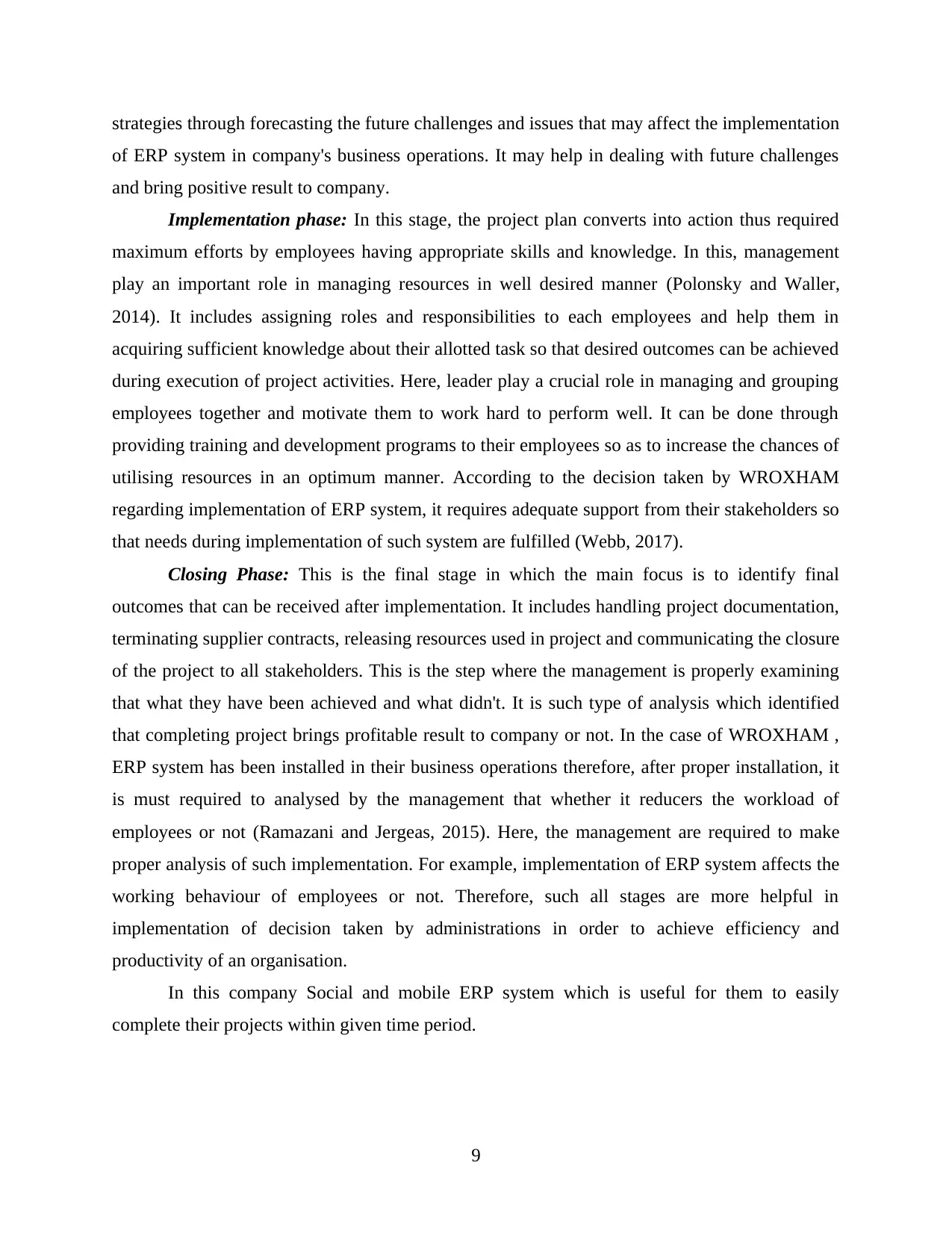
strategies through forecasting the future challenges and issues that may affect the implementation
of ERP system in company's business operations. It may help in dealing with future challenges
and bring positive result to company.
Implementation phase: In this stage, the project plan converts into action thus required
maximum efforts by employees having appropriate skills and knowledge. In this, management
play an important role in managing resources in well desired manner (Polonsky and Waller,
2014). It includes assigning roles and responsibilities to each employees and help them in
acquiring sufficient knowledge about their allotted task so that desired outcomes can be achieved
during execution of project activities. Here, leader play a crucial role in managing and grouping
employees together and motivate them to work hard to perform well. It can be done through
providing training and development programs to their employees so as to increase the chances of
utilising resources in an optimum manner. According to the decision taken by WROXHAM
regarding implementation of ERP system, it requires adequate support from their stakeholders so
that needs during implementation of such system are fulfilled (Webb, 2017).
Closing Phase: This is the final stage in which the main focus is to identify final
outcomes that can be received after implementation. It includes handling project documentation,
terminating supplier contracts, releasing resources used in project and communicating the closure
of the project to all stakeholders. This is the step where the management is properly examining
that what they have been achieved and what didn't. It is such type of analysis which identified
that completing project brings profitable result to company or not. In the case of WROXHAM ,
ERP system has been installed in their business operations therefore, after proper installation, it
is must required to analysed by the management that whether it reducers the workload of
employees or not (Ramazani and Jergeas, 2015). Here, the management are required to make
proper analysis of such implementation. For example, implementation of ERP system affects the
working behaviour of employees or not. Therefore, such all stages are more helpful in
implementation of decision taken by administrations in order to achieve efficiency and
productivity of an organisation.
In this company Social and mobile ERP system which is useful for them to easily
complete their projects within given time period.
9
of ERP system in company's business operations. It may help in dealing with future challenges
and bring positive result to company.
Implementation phase: In this stage, the project plan converts into action thus required
maximum efforts by employees having appropriate skills and knowledge. In this, management
play an important role in managing resources in well desired manner (Polonsky and Waller,
2014). It includes assigning roles and responsibilities to each employees and help them in
acquiring sufficient knowledge about their allotted task so that desired outcomes can be achieved
during execution of project activities. Here, leader play a crucial role in managing and grouping
employees together and motivate them to work hard to perform well. It can be done through
providing training and development programs to their employees so as to increase the chances of
utilising resources in an optimum manner. According to the decision taken by WROXHAM
regarding implementation of ERP system, it requires adequate support from their stakeholders so
that needs during implementation of such system are fulfilled (Webb, 2017).
Closing Phase: This is the final stage in which the main focus is to identify final
outcomes that can be received after implementation. It includes handling project documentation,
terminating supplier contracts, releasing resources used in project and communicating the closure
of the project to all stakeholders. This is the step where the management is properly examining
that what they have been achieved and what didn't. It is such type of analysis which identified
that completing project brings profitable result to company or not. In the case of WROXHAM ,
ERP system has been installed in their business operations therefore, after proper installation, it
is must required to analysed by the management that whether it reducers the workload of
employees or not (Ramazani and Jergeas, 2015). Here, the management are required to make
proper analysis of such implementation. For example, implementation of ERP system affects the
working behaviour of employees or not. Therefore, such all stages are more helpful in
implementation of decision taken by administrations in order to achieve efficiency and
productivity of an organisation.
In this company Social and mobile ERP system which is useful for them to easily
complete their projects within given time period.
9
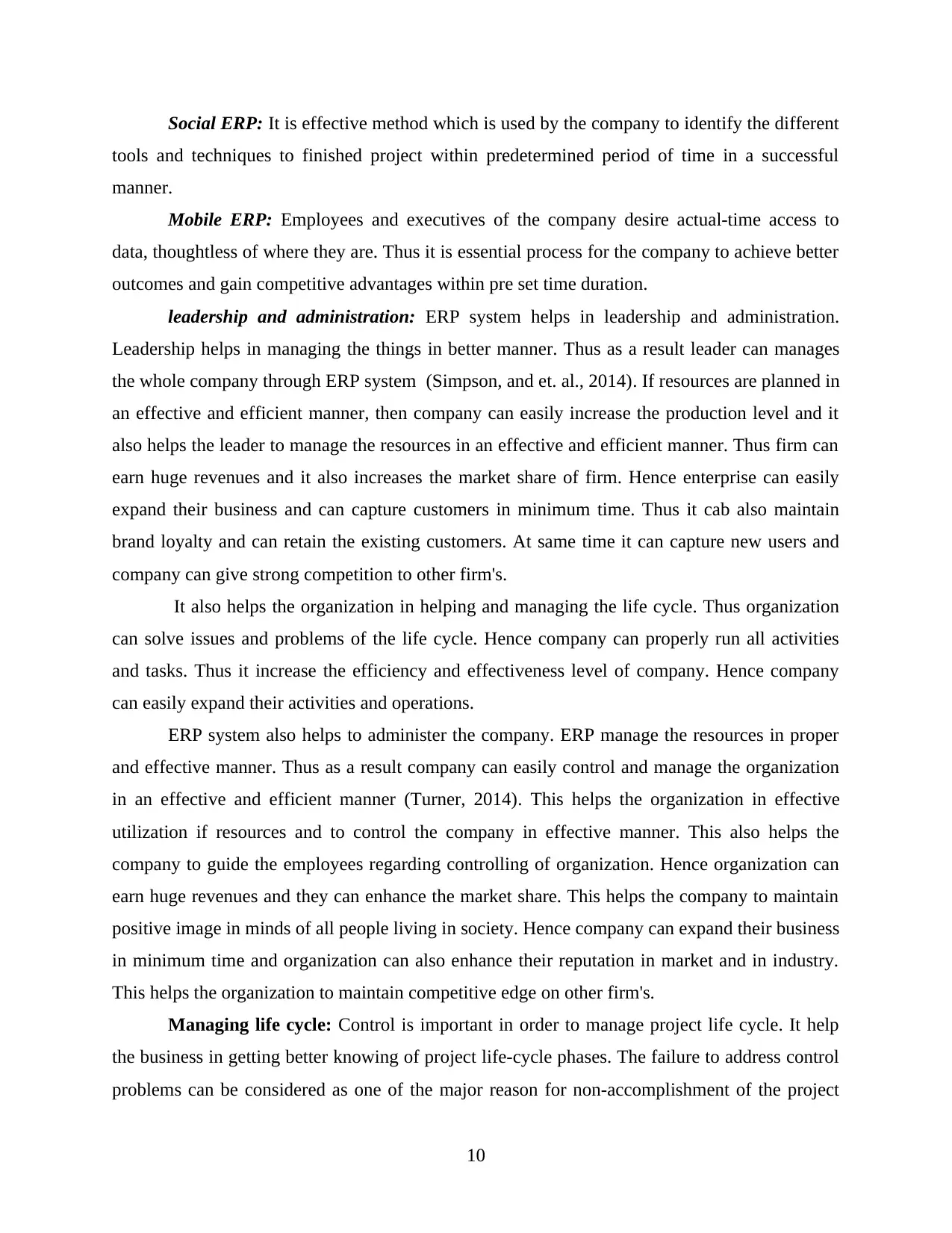
Social ERP: It is effective method which is used by the company to identify the different
tools and techniques to finished project within predetermined period of time in a successful
manner.
Mobile ERP: Employees and executives of the company desire actual-time access to
data, thoughtless of where they are. Thus it is essential process for the company to achieve better
outcomes and gain competitive advantages within pre set time duration.
leadership and administration: ERP system helps in leadership and administration.
Leadership helps in managing the things in better manner. Thus as a result leader can manages
the whole company through ERP system (Simpson, and et. al., 2014). If resources are planned in
an effective and efficient manner, then company can easily increase the production level and it
also helps the leader to manage the resources in an effective and efficient manner. Thus firm can
earn huge revenues and it also increases the market share of firm. Hence enterprise can easily
expand their business and can capture customers in minimum time. Thus it cab also maintain
brand loyalty and can retain the existing customers. At same time it can capture new users and
company can give strong competition to other firm's.
It also helps the organization in helping and managing the life cycle. Thus organization
can solve issues and problems of the life cycle. Hence company can properly run all activities
and tasks. Thus it increase the efficiency and effectiveness level of company. Hence company
can easily expand their activities and operations.
ERP system also helps to administer the company. ERP manage the resources in proper
and effective manner. Thus as a result company can easily control and manage the organization
in an effective and efficient manner (Turner, 2014). This helps the organization in effective
utilization if resources and to control the company in effective manner. This also helps the
company to guide the employees regarding controlling of organization. Hence organization can
earn huge revenues and they can enhance the market share. This helps the company to maintain
positive image in minds of all people living in society. Hence company can expand their business
in minimum time and organization can also enhance their reputation in market and in industry.
This helps the organization to maintain competitive edge on other firm's.
Managing life cycle: Control is important in order to manage project life cycle. It help
the business in getting better knowing of project life-cycle phases. The failure to address control
problems can be considered as one of the major reason for non-accomplishment of the project
10
tools and techniques to finished project within predetermined period of time in a successful
manner.
Mobile ERP: Employees and executives of the company desire actual-time access to
data, thoughtless of where they are. Thus it is essential process for the company to achieve better
outcomes and gain competitive advantages within pre set time duration.
leadership and administration: ERP system helps in leadership and administration.
Leadership helps in managing the things in better manner. Thus as a result leader can manages
the whole company through ERP system (Simpson, and et. al., 2014). If resources are planned in
an effective and efficient manner, then company can easily increase the production level and it
also helps the leader to manage the resources in an effective and efficient manner. Thus firm can
earn huge revenues and it also increases the market share of firm. Hence enterprise can easily
expand their business and can capture customers in minimum time. Thus it cab also maintain
brand loyalty and can retain the existing customers. At same time it can capture new users and
company can give strong competition to other firm's.
It also helps the organization in helping and managing the life cycle. Thus organization
can solve issues and problems of the life cycle. Hence company can properly run all activities
and tasks. Thus it increase the efficiency and effectiveness level of company. Hence company
can easily expand their activities and operations.
ERP system also helps to administer the company. ERP manage the resources in proper
and effective manner. Thus as a result company can easily control and manage the organization
in an effective and efficient manner (Turner, 2014). This helps the organization in effective
utilization if resources and to control the company in effective manner. This also helps the
company to guide the employees regarding controlling of organization. Hence organization can
earn huge revenues and they can enhance the market share. This helps the company to maintain
positive image in minds of all people living in society. Hence company can expand their business
in minimum time and organization can also enhance their reputation in market and in industry.
This helps the organization to maintain competitive edge on other firm's.
Managing life cycle: Control is important in order to manage project life cycle. It help
the business in getting better knowing of project life-cycle phases. The failure to address control
problems can be considered as one of the major reason for non-accomplishment of the project
10
⊘ This is a preview!⊘
Do you want full access?
Subscribe today to unlock all pages.

Trusted by 1+ million students worldwide
1 out of 14
Related Documents
Your All-in-One AI-Powered Toolkit for Academic Success.
+13062052269
info@desklib.com
Available 24*7 on WhatsApp / Email
![[object Object]](/_next/static/media/star-bottom.7253800d.svg)
Unlock your academic potential
Copyright © 2020–2025 A2Z Services. All Rights Reserved. Developed and managed by ZUCOL.





